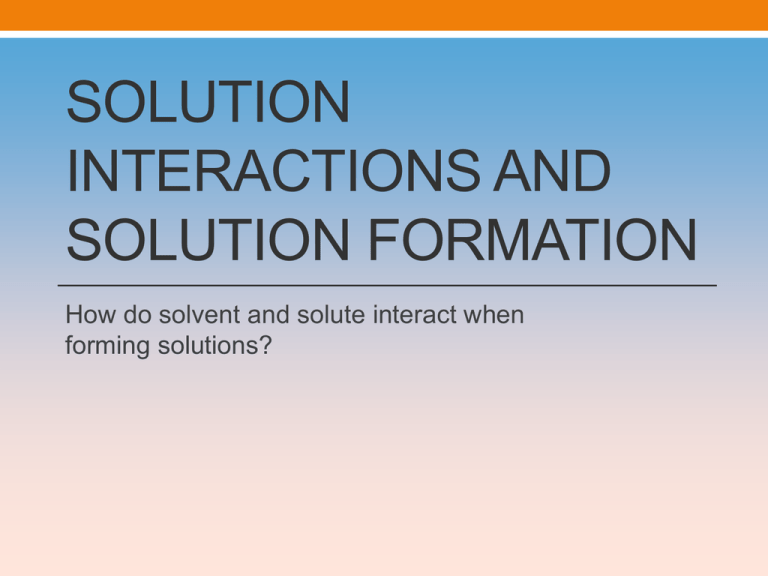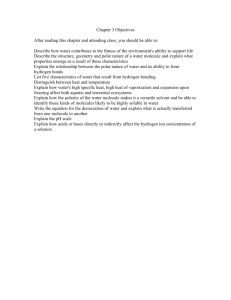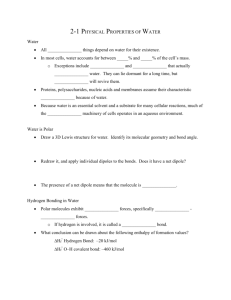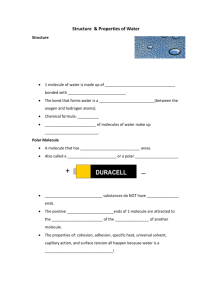Solution Interactions and Solution Formation
advertisement

SOLUTION INTERACTIONS AND SOLUTION FORMATION How do solvent and solute interact when forming solutions? Table of Contents • Part 1: Critical Thinking Questions • Parts of a solution • More examples of solutions • Intermolecular forces • IMF in molecules and IMF in solutions • Interactions in solutions • How do IMF determine if a solution will form? • Sugar/water and Oil/water • Cleaning paint brushes • Part 2: Solution Formation • When the solute is covalent • When the solute is ionic • When the solute is an acid PART ONE: CRITICAL THINKING QUESTIONS Return to Table of Contents Click here to continue… Question 1 Parts of a Solution Solvent Solute Solution Solute Solution Solvent Return to Table of Contents Click here to continue… Question 1 More Examples of Solutions Solute Solvent Solution Examples Gas Gas Gas Air (O2 dissolved in N2) Gas Liquid Liquid Liquid Liquid Liquid Solid Liquid Liquid Liquid Solid Solid Solid Solid Solid Return to Table of Contents Carbonated soda (CO2 in water), Swimming pool (Cl2 in water) Wine (ethanol in water) Vinegar (acetic acid in water) Salt Water Sugar Water Dental amalgam for fillings (liquid mercury in solid silver) Alloys (14 karat gold: solid silver and solid gold) Click here to continue… Question 2 What are Intermolecular Forces? Intramolecular forces: Forces between atoms which hold them together in molecules (i.e. chemical bonds) Intermolecular forces: Attractive forces between separate molecules, determines properties like state of matter, melting/ boiling point, volatility Return to Table of Contents Click here to continue… Question 3 What Kinds of IMF Exist between Molecules? 1. Dispersion • Occurs between all covalent molecules • Temporary changes in electron distribution causes short lived polar attractions between normally nonpolar molecules 2. Dipole-dipole • Occurs between polar covalent molecules • Positive pole of one molecule is attracted to the negative pole of another molecule 3. Hydrogen bonding • Occurs between molecules with H—F, H—O, or H—N bonds only • Partially positive hydrogen of one molecule is attracted to the partially positive F, O, or N of another molecule Return to Table of Contents Click here to continue… Question 4 What Kinds of IMF Exist in Solutions? • Three kinds: • Solute-solute (attractions between solute particles) • Solvent-solvent (attractions between solvent particles) • Solute-solvent (attractions between solute and solvent particles) In order for a solution to form: Solvent-solvent and Solute-solute interactions Return to Table of Contents < Must be weaker than Solute-solvent interactions Click here to continue… Question 5 Color Code Each Interaction Solute-solute interactions Solvent-solvent interactions Return to Table of Contents Solute-solvent interactions Now you color in the rest. Click here to continue… Question 6 How do IMF Determine if a Solution will Form? • Solutions form when the solute-solvent interactions overcome the solvent-solvent and solute-solute interactions • This only occurs when the solute and solvent are able to interact very strongly with each other – this occurs when solvent and solute have similar polarities. Water has regions of positive and negative charge – it’s polar! This fatty acid (from olive oil) is pretty much all nonpolar. Because water is polar and oil is nonpolar, they cannot interact, and do not dissolve. Remember: like dissolves like. Return to Table of Contents Click here to continue… Question 7 Sugar and Water • Glucose is a polar covalent molecule, meaning each glucose molecule has charges (which allow it to interact with water and dissolve). G Glucose, a sugar molecule Water, a polar solvent Draw your solution showing the solventsolvent, solute-solvent, and solute-solute interactions for sugar water. Remember, opposite charges attract while like charges repeal. Return to Table of Contents Click here to continue… Question 8 Oil and Water • Oil is a nonpolar molecule while water is a polar molecule. These different polarities mean that water and oil do not interact enough to form a solution. Oil Oil Oil Oil Oil, a nonpolar molecule Water, a polar solvent Draw your solution showing the solventsolvent, solute-solvent, and solute-solute interactions for oil and water. Remember, oil and water do not strongly interact. Return to Table of Contents Click here to continue… Question 9 Cleaning Paint Brushes Nonpolar Polar Compare the structure of turpentine to linseed oil. • Are they polar or nonpolar? • What types of elements are present? Compare the structure of water to linseed oil. • Are they polar or nonpolar? • What types of elements are present? Return to Table of Contents Which should you use to clean the oil paint off of the brushes, water or turpentine? Click here to continue… PART TWO: SOLUTION FORMATION Return to Table of Contents Click here to continue… Question 10 When Polar Covalent Molecules Dissolve + + - G - G + G + G G G G G - G G G Glucose is a polar covalent molecule with lots of positive and negative charges. G Glucose (Sugar) Cube Glucose Molecule Return to Table of Contents When many glucose molecules are bonded together, they for a glucose crystal, such as a sugar cube. Click here to continue… Question 10 When Polar Covalent Molecules Dissolve Click to add the glucose to the water. This process is simply referred to as dissolving. G G G G G G G G G G G Notice that the sugar is still a molecule – the atoms didn’t break Before apart. The water molecules surround the glucose, based on charge. Return to Table of Contents G G G G G After G G G G G G G G Click here to continue… Question 10 When Ionic Substances Dissociate +1 -1 +1 -1 +1 -1 +1 -1 +1 Before Adding to Water +1 Sodium Cation -1 Chloride Anion Return to Table of Contents Ionic substances, such as NaCl, are made of cations and anions. They already are made of charges. Click here to continue… Question 10 When Ionic Substances Dissociate Click to add the NaCl to the water. + + + - After Adding to Water + + Before Adding to Water + Once the salt is added, water molecules begin colliding with the salt crystal. This process is called dissociation, because the charges in the ionic substance already exist, they just need to break apart (dissociate) from each other. Return to Table of Contents Once the ions break away from the crystal, water molecules surround them based on charge. + - + - + + - + + - + - + + - + Click here to continue… Question 10 When Acids Ionize HCl is a polar molecule. The chloride “pulls” much harder on the shared electrons, causing unequal sharing. When added to water, the water molecules will collide with the HCl molecules, causing the HCl atoms to become fully charged (ionized) as they form solution. δ+ H Cl δThis is due to the differing electro negativities of the atoms – Cl is more electronegative than H. Return to Table of Contents HCl has partial charges, it does not have full charges. Click here to continue… Question 10 When Acids Ionize + - (HCl is a liquid) Before Adding to Water When water collides with the HCl, some electrons are switched around, leading to the formation of ions. This is called ionization, because new ions are formed. Return to Table of Contents After Adding to Water +






